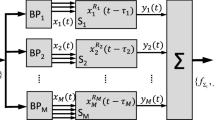Abstract
The potential evoked by a ‘train’ of N equally spaced auditory clicks, with an inter-click period shorter than the duration of the response to an isolated click, is said to be a steady-state response (SSR). Extracting the individual responses evoked by the clicks of the train during steady state can be key to understanding of the neurophysiological mechanisms underlying SSR generation. In the literature, this task has been dealt with only under the (unwarranted) assumption that the response of the system does not vary during the presentation of the clicks, i.e. no neurophysiological adaptation is present. In this work, a new, non-parametric algorithm is proposed that, relaxing the time-invariance hypothesis, allows the extraction from the SSR of the N waveforms individually evoked by the N clicks of the train. The performance of the approach is evaluated on simulated SSRs and on real data recorded from the temporal cortex of awake rats. Results show that the method is able to detect and assess possible adaptation of the neurophysiological system in the generation of SSRs.
Similar content being viewed by others
References
Azzena, G. B., Conti, G., Santarelli, R., Ottaviani, F., Paludetti, G., andMaurizi, M. (1995): ‘Generation of human auditory steady-state responses (SSRs). I: Stimulus rate effects’,Hear. Res.,83, pp. 1–8
Bonhomme, V., Plourde, G., Meuret, P., Fiset, P., andBackman, S. B. (2000): ‘Auditory steady-state response and bispectral index for assessing level of consciousness during propofol sedation and hypnosis’,Anesth. Analg.,91, pp. 1398–1403
De Nicolao, G., Sparacino, G., andCobelli, C. (1997): ‘Nonparametric input estimation in physiological systems: Problems, methods, case studies’,Automatica,33, pp. 851–870
Erwin, R. J., andBuchwald, J. S. (1986): ‘Midlatency auditory evoked responses: differential recovery cycle characteristics’,Electroencephalogr: Clin. Neurophysiol.,64, pp. 417–423
Galambos, R., Makeig, S., andTalmachoff, P. J. (1981): ‘A 40-Hz auditory potential recorded from the human scalp’,Proc. Natl. Acad. Sci. USA,78, pp. 2643–2647
Gutschalk, A., Mase, R., Roth, R., Ille, N., Rupp, A., Hahnel, S., Picton, T. W., andScherg, M. (1999): ‘Related deconvolution of 40 Hz steady-state fields reveals two overlapping source activities of the human auditory cortex’,Clin. Neurophysiol.,110, pp. 856–868
Hari, R., Hamalainen, M., andJoutsiniemi, S. L. (1989): ‘Neuromagnetic steady-state responses to auditory stimuli’,J. Acoust. Soc. Am.,86, pp. 1033–1039
Liberati, D., Bertolini, L., andColombo, D. C. (1991): ‘Parametric method for the detection of inter- and intrasweep variability in VEP processing’,Med. Biol. Eng. Comput.,29, pp. 159–166
Liberati, D., Narici, L., Santoni, A., andCerutti, S. (1992): ‘The dynamic behaviour of the evoked magnetoencephalogram detected through parametric identification’,J. Biomed. Eng.,14, pp. 57–63
Picton, T. W., Champagne, S. C., andKellet, A. J. C. (1992): ‘Human auditory evoked potentials recorded using maximum length sequences,’Electroenceph. Clin. Neurophysiol.,84, pp. 90–100
Plourde, G., andVillemure, C. (1996): ‘Comparison of the effects of enflurane/N2O on the 40-Hz auditory steady-state response versus the auditory middle-latency response’,Anesth. Analg.,82, pp. 75–83
Santarelli, R., Maurizi, M., Conti, G., Ottaviani, F., Paludetti, G., andPettorossi, V. E. (1995): ‘Generation of human auditory steady-state responses (SSRs): II: Addition of responses to individual stimuli’,Hear. Res.,83, pp. 9–18
Santarelli, R., andConti, G. (1999): ‘Generation of auditory steady-state responses: linearity assessment’,Scand. Audiol. Suppl.,51, pp. 23–32
Santarelli, R., Carraro, L., Conti, G., Capello, M., Plourde, G., andArslan, E. (2003): ‘Effects of isoflurane on auditory middle latency (MLRs) and steady-state (SSRs) responses recorded from the temporal cortex of the rat’,Brain Res.,973, pp. 240–251
Stapells, D. R., Linden, D., Suffield, J. B., Hamel, G., andPicton, T. W. (1984): ‘Human auditory steady state potentials’,Ear Hear.,5, pp. 105–113
Verotta, D. (1993): ‘Estimation and model selection in constrained deconvolution’,Ann. Biomed. Eng.,21, pp. 605–620
Author information
Authors and Affiliations
Corresponding author
Rights and permissions
About this article
Cite this article
Sparacino, G., Nale, A., Santarelli, R. et al. Method for the deconvolution of auditory steady-state responses. Med. Biol. Eng. Comput. 42, 569–576 (2004). https://doi.org/10.1007/BF02351001
Received:
Accepted:
Issue Date:
DOI: https://doi.org/10.1007/BF02351001




